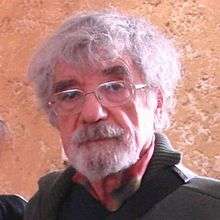Humberto Maturana

Humberto Maturana (born September 14, 1928 in Santiago, Chile) is a Chilean biologist. Many consider him a member of a group of second-order cybernetics theoreticians such as Heinz von Foerster, Gordon Pask, Herbert Brün and Ernst von Glasersfeld.
Maturana, along with Francisco Varela and Ricardo B. Uribe, is particularly known for creating the term "autopoiesis" about the self-generating, self-maintaining structure in living systems, and concepts such as structural determinism and structure coupling.[1] His work has been influential in many fields, mainly the field of systems thinking and cybernetics. Overall, his work is concerned with the biology of cognition.[2]
Life and career
After completing secondary school at the Liceo Manuel de Salas in 1947, Maturana enrolled at the University of Chile, studying first medicine then biology. In 1954, he obtained a scholarship from the Rockefeller Foundation to study anatomy and neurophysiology at University College London. He obtained a PhD in biology from Harvard University in 1958.[3]
He works in neuroscience at the University of Chile, in the research center "Biología del Conocer" (Biology of Knowledge). Maturana's work has been developed and integrated into the work on Ontological coaching done by Fernando Flores and Julio Olalla.
As of 2000, Maturana established his own reflection and research center, the Instituto de Formación Matriztica.
Work
Maturana's research interest concerns concepts like cognition, autopoiesis, languaging, zero time cybernetics and structural determined systems. Maturana's work extends to philosophy and cognitive science and even to family therapy. He was early inspired by the work of the biologist Jakob von Uexküll.
His inspiration for his work in cognition came while he was a medical student and became seriously ill with tuberculosis. Confined in a sanatorium with very little to read, he spent time reflecting on his condition and the nature of life. What he came to realize was "that what was peculiar to living systems was that they were discrete autonomous entities such that all the processes that they lived, they lived in reference to themselves ... whether a dog bites me or doesn't bite me, it is doing something that has to do with itself." This paradigm of autonomy formed the basis of his studies and work.[2]
Maturana and his student Francisco Varela were the first to define and employ the concept of autopoiesis. Aside from making important contributions to the field of evolution, Maturana is associated with an epistemology built upon empirical findings of neurobiology. Maturana and Varela wrote in their Santiago Theory of Cognition: "Living systems are cognitive systems, and living as a process is a process of cognition. This statement is valid for all organisms, with or without a nervous system."[4]
In popular culture
Maturana influenced - and appears in coded form as a character in - the novel Replay by German author Benjamin Stein.
See also
Publications
The initial ground-breaking paper which stands as a prelude to all that followed:
- BIOLOGY OF COGNITION. Humberto R. Maturana. Biological Computer Laboratory Research Report BCL 9.0. Urbana IL: University of Illinois, 1970. As Reprinted in: Autopoiesis and Cognition: The Realization of the Living. Dordecht: D. Reidel Publishing Co., 1980, pp. 5–58.
Books, a selection:
- 1979 Autopoiesis and Cognition: The Realization of the Living With Francisco Varela. Boston Studies in the Philosophy of Science). Paperback, 1991.
- 1984. The tree of knowledge. Biological basis of human understanding. With Francisco Varela Revised edition (92) The Tree of Knowledge: Biological Roots of Human Understanding. ISBN 978-0-87773-642-4
- 1990. Biology of Cognition and epistemology. Ed Universidad de la Frontera. Temuco, Chile.
- 1992 Conversations with Humberto Maturana: Questions to biologist Psychotherapist. With K. Ludewig. Ed Universidad de la Frontera. Temuco, Chile. 1992.
- 1994. Reflections and Conversations. With Kurt Ludewig. Collection Family Institute. FUPALI Ed. Cordova. 1994
- 1994. Democracy is a Work of Art. Collection Roundtable. Linotype Ed Bogota Bolivar y Cia.
- 1997 Objectivity - An argument to force. Santiago de Chile: Ed Dolmen.
- 1997 Machines and living things. Autopoiese to do Organização Vivo. With Francisco Varela Porto Alegre: Medical Arts, 1997.
- 2004. From Being to Doing, The Origins of the Biology of Cognition. With Bernhard Poerksen. Paperback, 2004
- 2009. The Origins of humanness in the Biology of Love. With Gerda Verden-Zoller and Pille Brunnel
- 2004. From biology to psychology. Paperback.
- 2009. Sense of humanity. Paperback.
References
- ↑ Maturana, Humberto & Varela, Francisco ([1st edition 1973] 1980). Autopoiesis and Cognition: the Realization of the Living. Robert S. Cohen and Marx W. Wartofsky (Eds.), Boston Studies in the Philosophy of Science 42. Dordecht: D. Reidel Publishing Co. ISBN 90-277-1015-5 (hardback), ISBN 90-277-1016-3 (paper) &mdash
- 1 2 Magnus Ramage, Karen Shipp (2012) Systems Thinkers
- ↑ See more biographical details in History: The Biology of Cognition Laboratory of the Universidad de Chile (1960–2006). Juan-Carlos Letelier, Gonzalo Marin & Jorge Mpodozis. Published online at.http://biologyofcognition.wordpress.com/about/
- ↑ Maturana, Humberto R./Varela, Francisco J. (1980): Autopoiesis and Cognition. The Realization of the Living. Dordrecht: Reidel, p. 13.
Further reading
- Alexander Riegler and Pille Bunnell (eds.) (2011) The Work of Humberto Maturana and Its Application Across the Sciences. Special issue. Constructivist Foundations 6(3): 287–406, freely available at the journal's web site
External links
| Wikiquote has quotations related to: Humberto Maturana |
- Humberto Maturana official website
- Cultural Biology Certification - Brazil
- Biology of Cognition Lab website